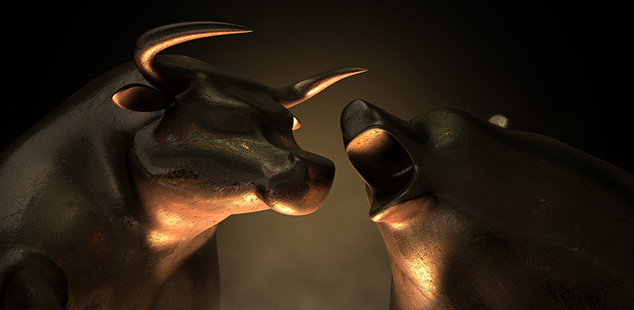
While the conventional wisdom about financial markets is that they “hate uncertainty,” many analysts today have come to see such chaos as an essential part of what makes them work. In fact, they argue that the real problems occur when nearly everyone is certain the market is going to move one way or the other.
Bulls and Bears in a Crowd
The argument goes that it was such certainty that produced the dot-com bust (prices would never go down) as well as the 2008–2009 meltdown (prices would never get out of the cellar they had fallen to).
Regardless of which theory is correct, it is certain that today’s markets have a significant level of uncertainty. Many argue that the U.S. is just one more bad report from entering another downturn, and they point to the reaction from the recent jobs report as a current example.
However, many other analysts point to how the election year might tweak the economy, depending on what the results are. These individuals and firms point to the ongoing hesitancy of the Fed to take action on interest rates—notwithstanding the supposed political neutrality of this critical agency.
Making an Equal Case for Either Side
The reality is that equally bright and experienced analysts can make convincing arguments for both sides of the question of how the economy will perform over the coming two or three quarters. Adding to the frustration of any effort to sort out these issues and rely on the “experts” is the issue of crude oil prices. Virtually no one saw such a precipitous drop, and that blindsiding has everyone hesitant to predict a rise in prices anytime soon.
In fact, the oil price chaos is a major part of the market’s confusion. The price is down because of both supply and demand pressures coming into play. However, the lower price would normally cause an increase in demand as lower costs spurred manufacturers to take advantage of the situation. Yet, even in this situation we see China causing tremors and Europe still barely growing, muting the advantages of lower fuel prices. All this is taking place while the Dow is its own roller coaster.
Neither Fear Nor Confidence
Collectively, these and a multitude of other factors (as in the Iranian treaty, to name just one) have the markets in something of a standstill. Too few are scared enough to sell off equities and rush to the security of precious metals, while even the bravest are hesitant to commit to a solid upswing.
For the near term, the savvy investors and traders seem to be nervously checking the vital signs, waiting anxiously for word the patient is a code blue or ready to jump out of the bed. This has many quietly buying bargains in their markets and taking small profits in others.
This is especially the case with gold buyers and gold sellers. They know the low fuel prices mean lower production costs, and that means more supply and downward pressure on prices. At the same time, all the uncertainty would normally be driving some solid gold buying. More than normally, it is important for traders and investors to keep their powder dry. That means being ready to deploy when there are more definitive signals indicating a solid market turn one way or the other.
Additional Sources:
1 – http://www.ft.com/cms/s/0/d3ec5c08-ca26-11e3-8a31-00144feabdc0.html
2 – http://www.ritholtz.com/blog/2010/11/the-uncertainty-myth/

